Pre-Modern Global Perspectives Greek-Roman Art
1/95
There's no tags or description
Looks like no tags are added yet.
Name | Mastery | Learn | Test | Matching | Spaced |
|---|
No study sessions yet.
96 Terms

Dipylon Geometric Krater
Geometric period. used as a grave marker for important people (man). decorated with geometric patterns and figures arranged in bands. One scene shows a funeral procession, where people are mourning around the body of the deceased laid out on a platform.
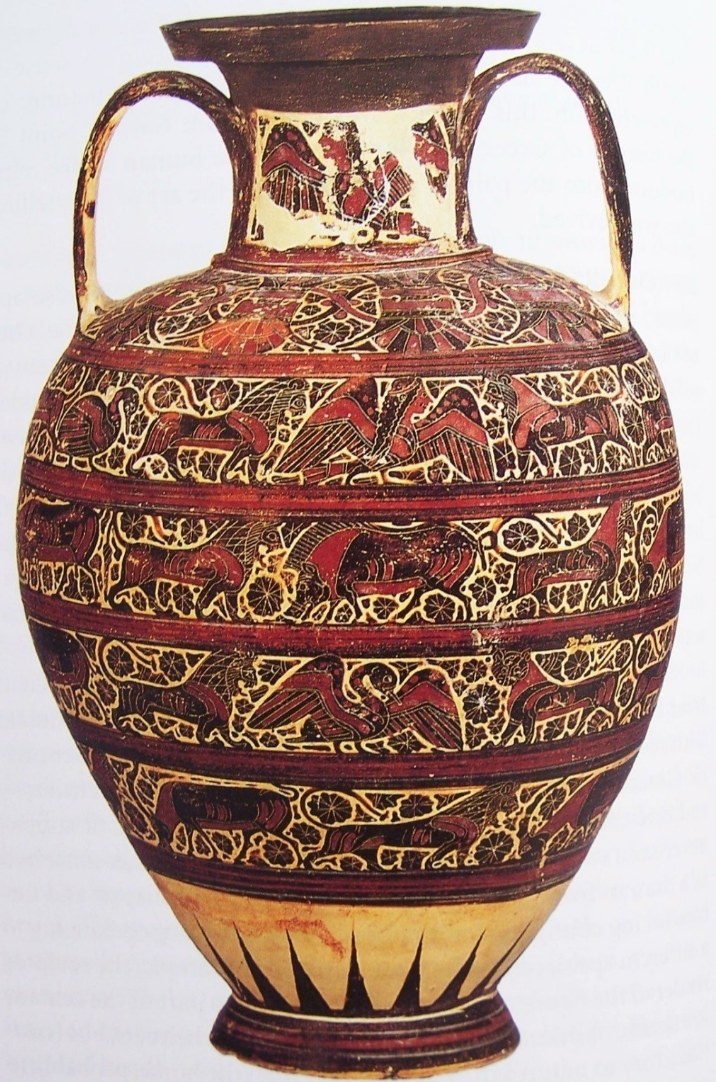
Corinthian Black-Figure Amphora
Orientalizing Period. It’s an amphora, meaning it has two handles and was used to store liquids like oil or wine.
The black-figure technique was used — artists painted figures in black slip (a liquid clay), then scratched in details with a sharp tool before firing the vase.
Typical decorations include animals (like lions, panthers, and birds) arranged in friezes, showing the influence of Eastern art.
The background was often filled with rosettes and decorative patterns to fill empty space.
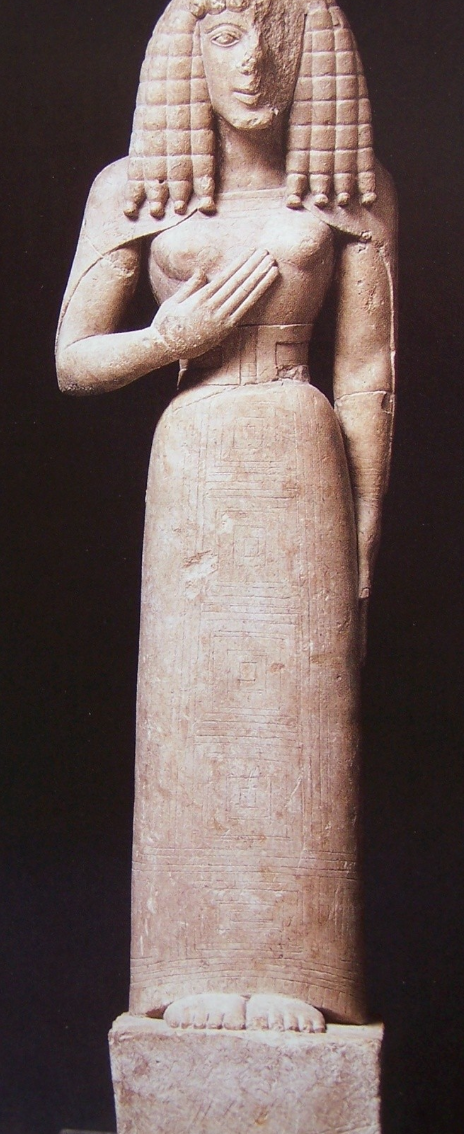
Lady of Auxerre
Orientilizing
She represents a standing woman, possibly a goddess or a kore (young maiden).
Her style is rigid and geometric, with a triangular face, patterned hair, and a stiff posture.
Her clothing, a long dress called a peplos, is decorated with carved patterns.
The statue still shows traces of paint, meaning it was originally colorful, not plain stone.
It’s called the Lady of Auxerre because it was discovered in a museum in Auxerre, France, though it was made in Crete.

Kouros, ca. 600 BCE
Archaic Period

Calf-Bearer
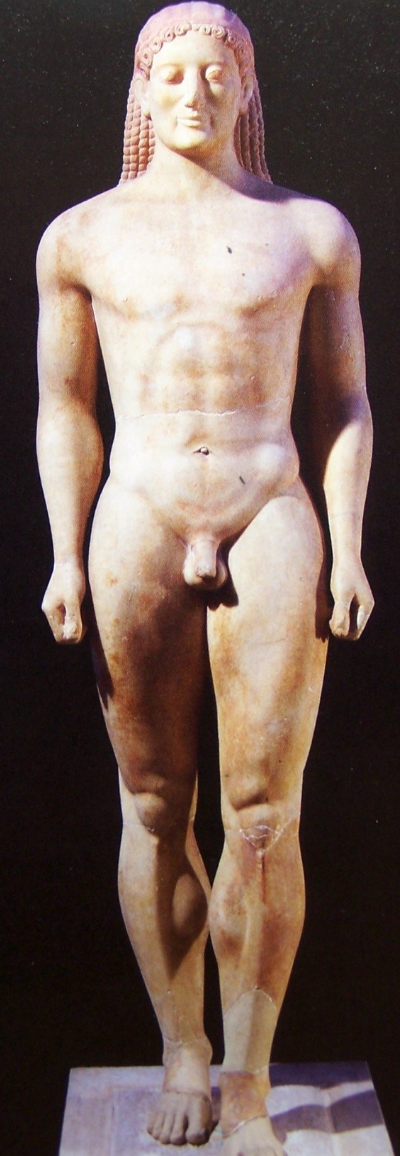
Kroisos
Archaic period
It was made as a grave marker for a warrior named Kroisos, who died in battle.
Like earlier kouroi, it shows a nude, standing male figure with one leg forward.
However, it looks more natural and realistic than earlier examples — the body has softer muscles, more natural proportions, and a lifelike stance.
The face still has the “Archaic smile,” a small grin meant to show vitality.

Temple of Hera I
Also called the Basilica
Archaic Period
Doric order
It has heavy, closely spaced columns (9 across the front and 18 along the sides), giving it a sturdy, solid look.
Inside, it had a central room (cella) where the statue of Hera would have stood.
The design still feels primitive and experimental, showing how early Greek builders were learning to perfect temple proportions.
entisis
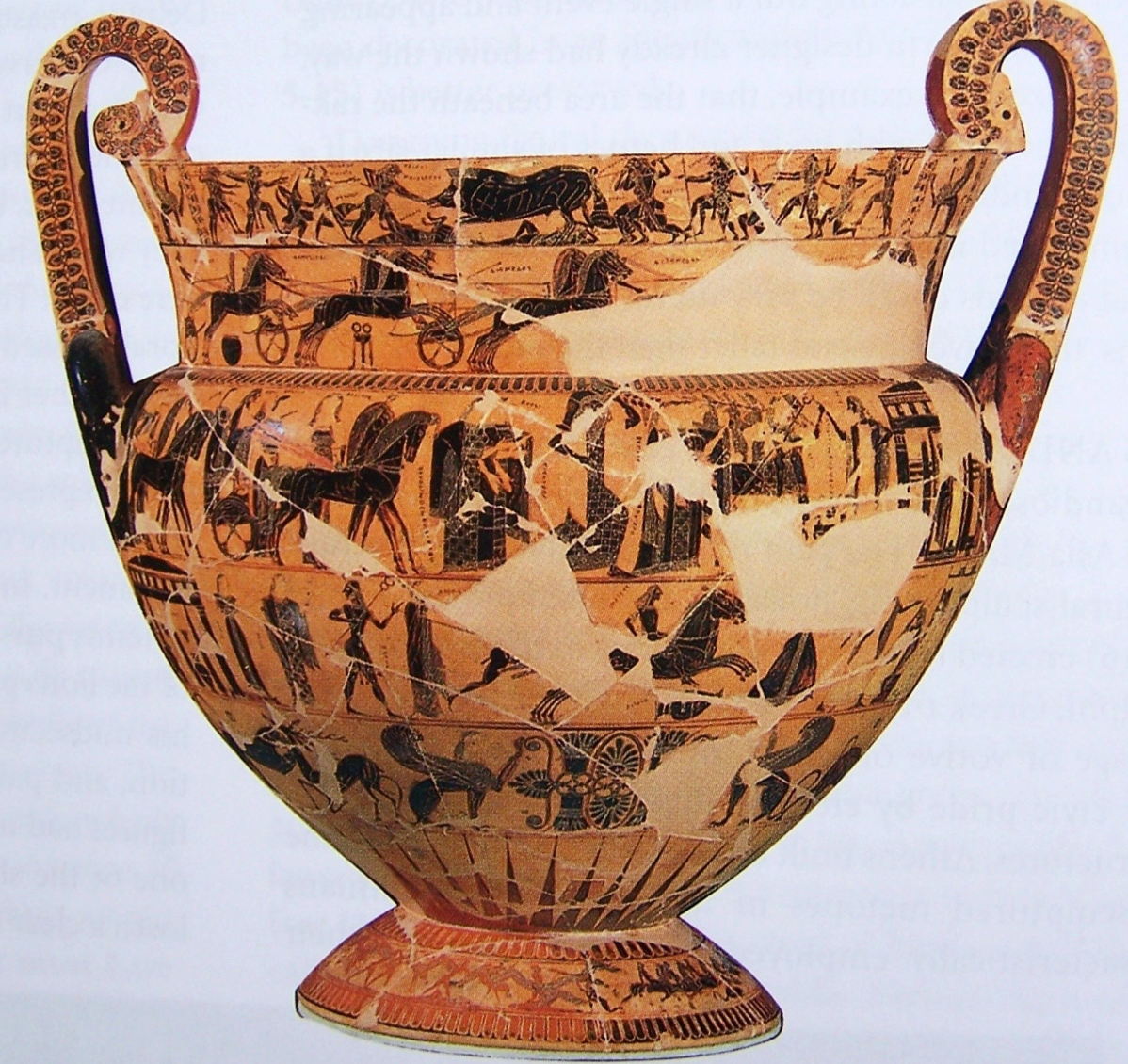
Franҫois Vase
Greek black-figure krater (mixing bowl)
Archaic period.
It was made by the potter Ergotimos and painted by the artist Kleitias — their names are even written on the vase.
The vase is covered with detailed mythological scenes — over 200 figures showing famous Greek myths, like the Trojan War, the Calydonian Boar Hunt, and the wedding of Peleus and Thetis (Achilles’s parents).
It uses the black-figure technique, where figures are painted in black slip and details are scratched in.

Three Revelers Amphora
Archaic Period
Greek red figure vase - where the figures are left the color of the clay and the background is painted black
Amphora (a two-handled jar) used for storing wine.
Shows three men dancing and celebrating, likely after drinking — hence the name “Revelers.”
The artist focused on movement and perspective — each figure is shown in a different pose, twisting and turning, which was new and impressive for the time.
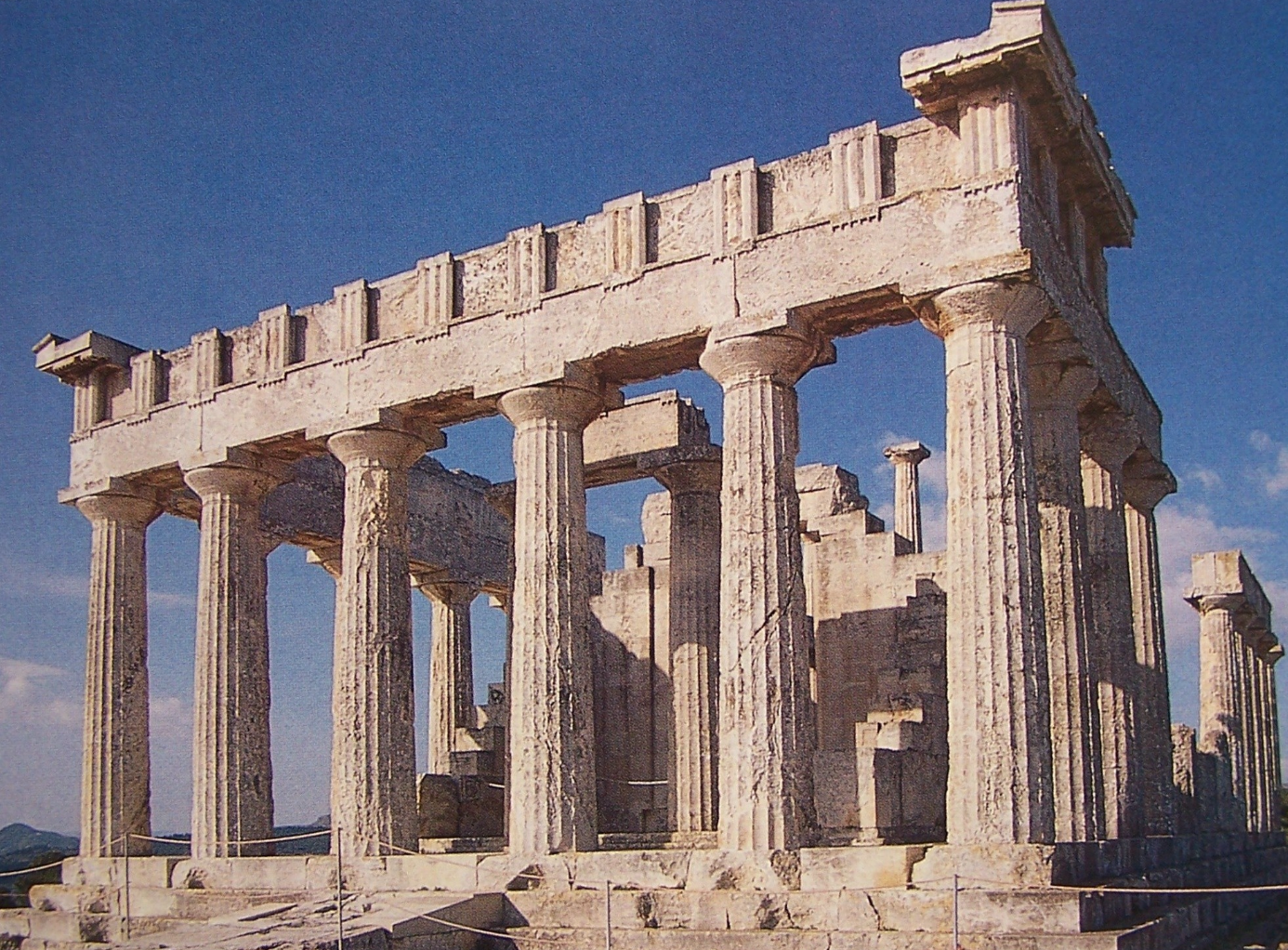
Temple of Aphaia, Aegina (building and pediment sculptures)
Archaic
doric temple
The Building:
It was dedicated to the goddess Aphaia, a local deity associated with fertility and hunting.
The temple is in the Doric order, with 6 columns across the front and 12 along the sides.
It’s made of limestone covered with stucco, giving it a clean, white appearance.
The design is balanced and harmonious, showing how Greek architecture was becoming more refined and elegant compared to earlier temples like the Temple of Hera I.
The Pediment Sculptures:
The temple had two pediments (triangular areas above the ends of the roof), each showing scenes from the Trojan War.
Athena stands at the center of both, as the goddess of war and wisdom.
The east pediment shows younger, more naturalistic warriors, while the west pediment shows older, stiffer Archaic-style figures.
The difference between the two shows the shift from Archaic stiffness to Classical realism — figures begin to move more naturally and show real emotion.

East Pediment, Temple of Zeus, Olympia
Classical period
It shows the story of Pelops and Oinomaos, a chariot race to win Hippodamia.
Zeus is in the center, watching the scene.
The people and horses are shown moving naturally, with realistic muscles and poses.
This sculpture marks the shift from stiff Archaic figures to more lifelike, Early Classical figures.
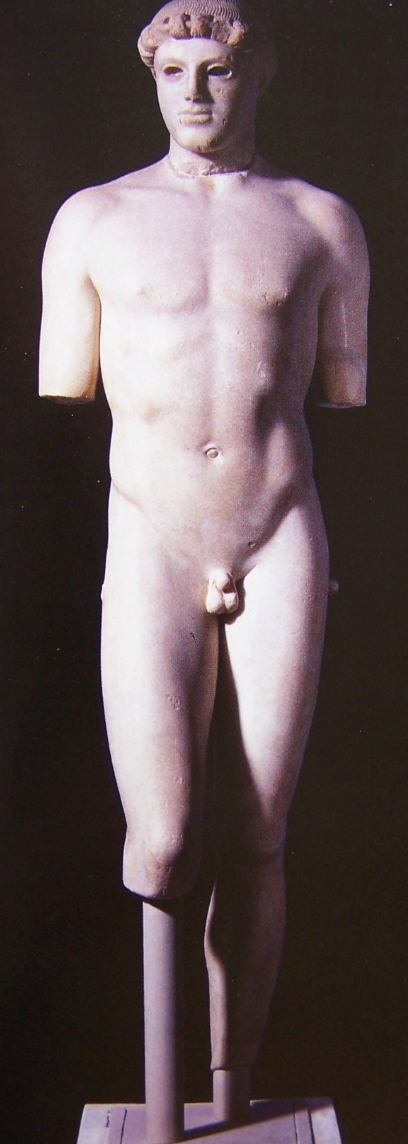
Kritios Boy
Classical
It represents a young male athlete.
Kritios Boy has a natural stance, with weight shifted onto one leg — this is called contrapposto.
The muscles, posture, and face look more realistic, though still calm and idealized.

Diskobolos (Discus Thrower)
Classical
time
It shows an athlete throwing a discus in the middle of the action.
The body is captured in perfect balance and harmony, with muscles and movement shown realistically.
The pose demonstrates contrapposto and a twisting motion, making it very dynamic.
It represents the Greek ideal of strength, beauty, and athletic skill.
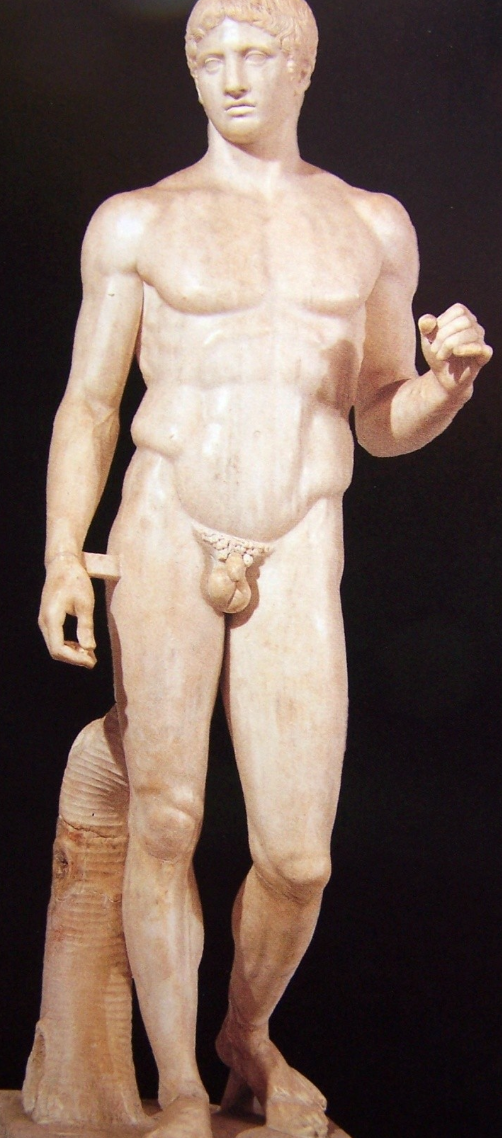
Doryphoros (Spear Bearer, Canon)
Classical Period
It shows a male athlete holding a spear, standing in a relaxed, natural pose called contrapposto (weight on one leg).
Polykleitos created it to show perfect human proportions, described in his treatise called the Canon.
The body is idealized, with balanced muscles and harmonious proportions, showing Greek ideas of beauty and strength.

Parthenon (building, Panathenaic Processional Frieze, pediments)
Classical period
dedicated to athena
The Building:
It is in the Doric order, with some Ionic elements inside.
Made of marble, it has 8 columns at the front and 17 along the sides.
The temple shows perfect balance, symmetry, and proportion, typical of Classical Greek architecture.
Panathenaic Processional Frieze:
A long carved band around the inner wall of the temple shows the Panathenaic Festival, a celebration in honor of Athena.
Figures include people, animals, and gods, all in naturalistic poses, participating in a procession or sacrifice.
Pediments:

Erechthieon
Classical period
t was dedicated to Athena and Poseidon, and also honored the mythical king Erechtheus.
The temple is asymmetrical because it had to fit uneven ground and include multiple sacred spots, unlike the perfectly balanced Parthenon.
It is famous for the Porch of the Caryatids, where six female figures (caryatids) serve as columns supporting the roof.
The Erechtheion blends function, religion, and artistry, showing advanced Greek architectural skill.
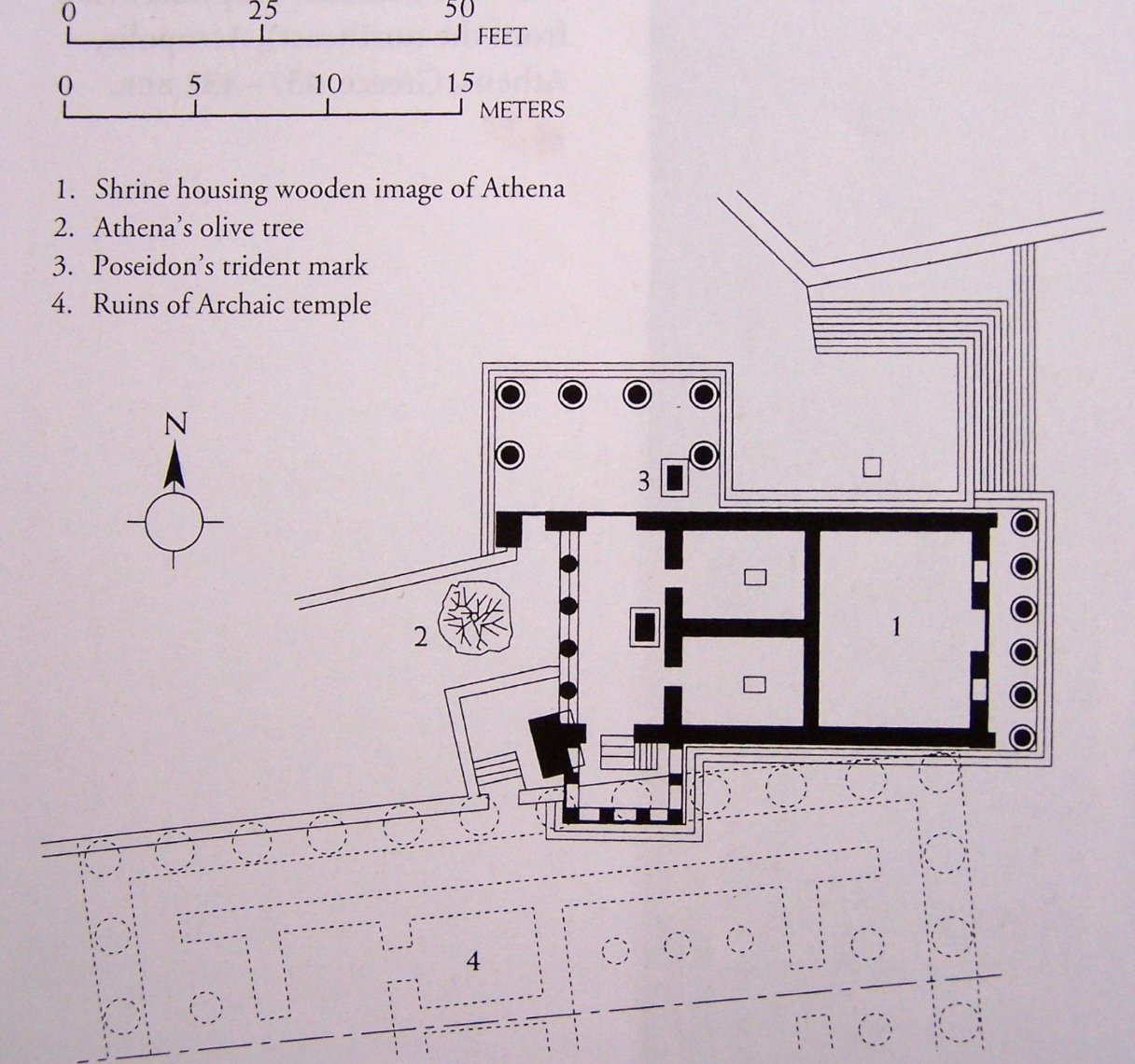
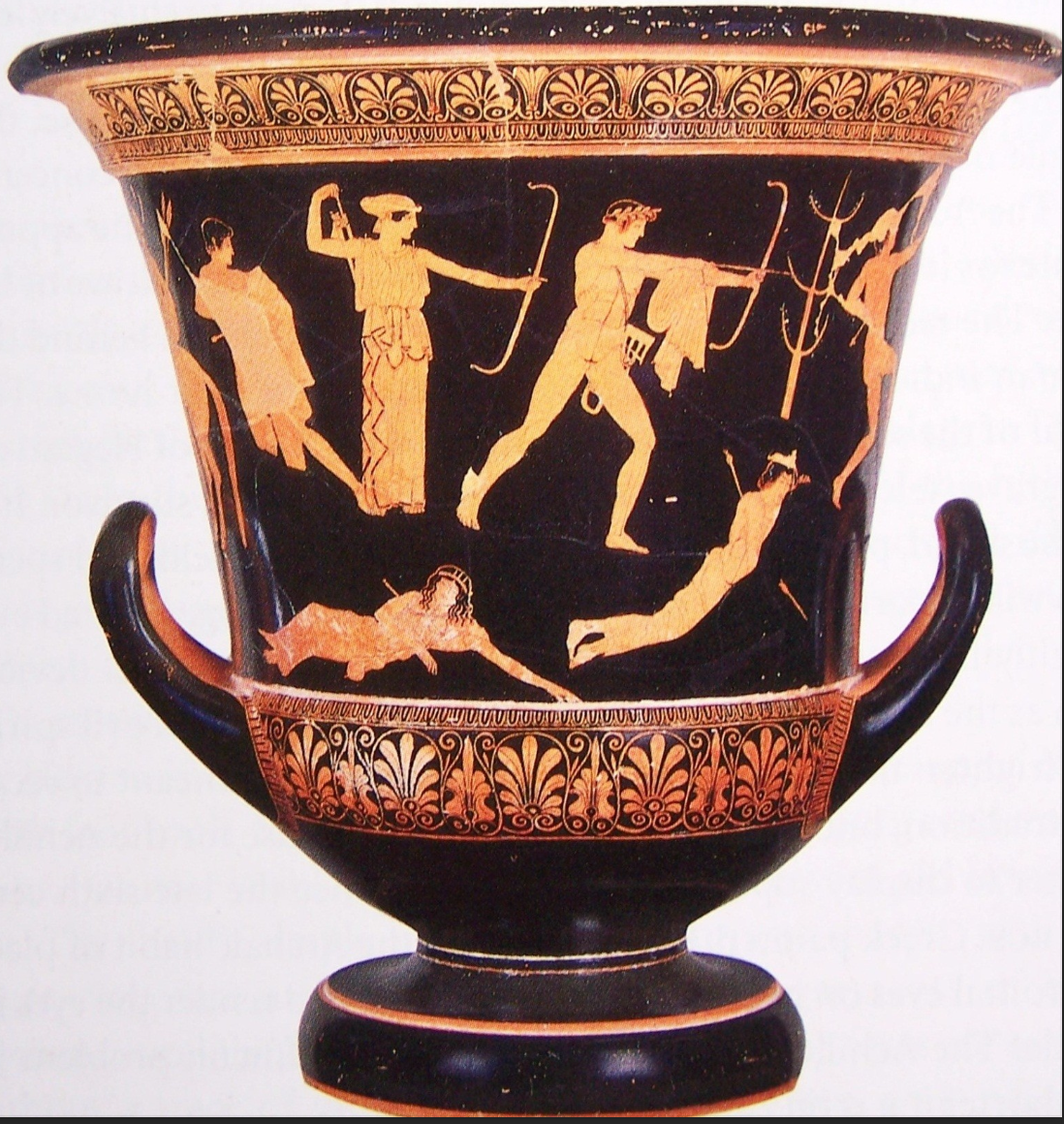
Niobid Vase (Apollo and Artemis Slaying the Children of Niobe)
Classical period
It shows the story of Niobe, whose children were slain by Apollo and Artemis because Niobe boasted she was superior to their mother, Leto.
The figures are painted using the red-figure technique, allowing more detailed and naturalistic poses.
The people and gods are arranged in a way that shows depth and movement, an early attempt at creating a sense of space.
It reflects Greek interest in myth, drama, and realistic human anatomy.
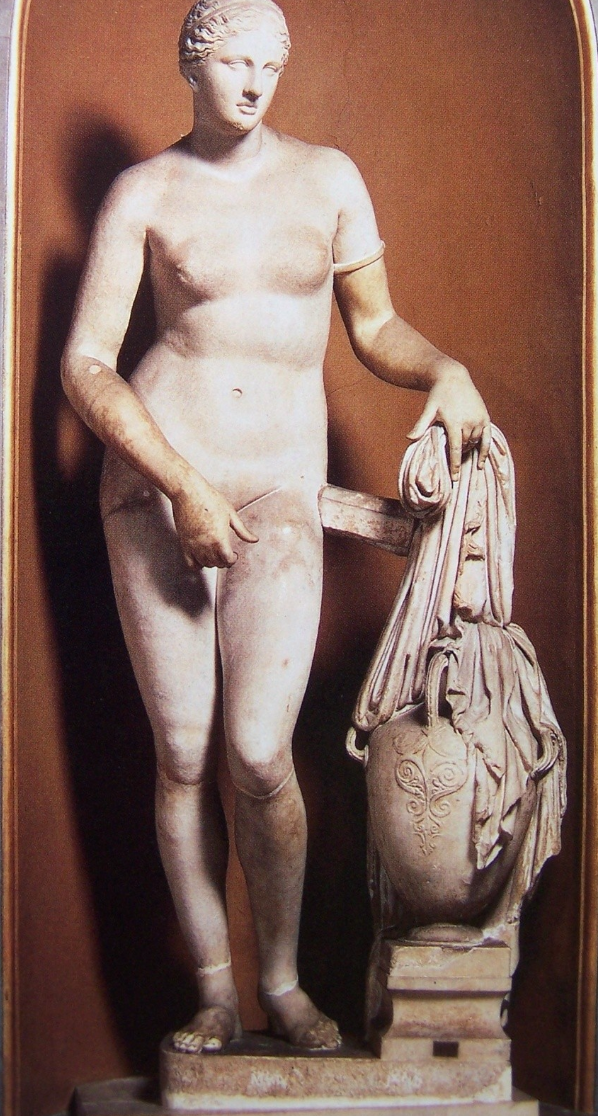
Aphrodite of Knidos
made by Praxiteles
late classical
It shows Aphrodite, the goddess of love, nude, which was groundbreaking because earlier female statues were always clothed.
The pose is modest yet sensual, often called the “modest Venus” pose, with one hand covering herself.
The body is soft, natural, and lifelike, with realistic curves and relaxed posture.
It was one of the first Greek sculptures to depict a fully nude female figure in a respectful and idealized way.

Scraper
late classical
made by Lysippos
It shows an athlete scraping oil and sweat off his body with a small tool called a strigil, a common practice in ancient Greek athletics.
The pose is dynamic and natural, with the body twisting in space, showing movement from multiple angles.
Lysippos made the figure slimmer and taller than earlier statues, creating a new ideal of proportion.
The sculpture emphasizes realism and human action, rather than just standing poses.
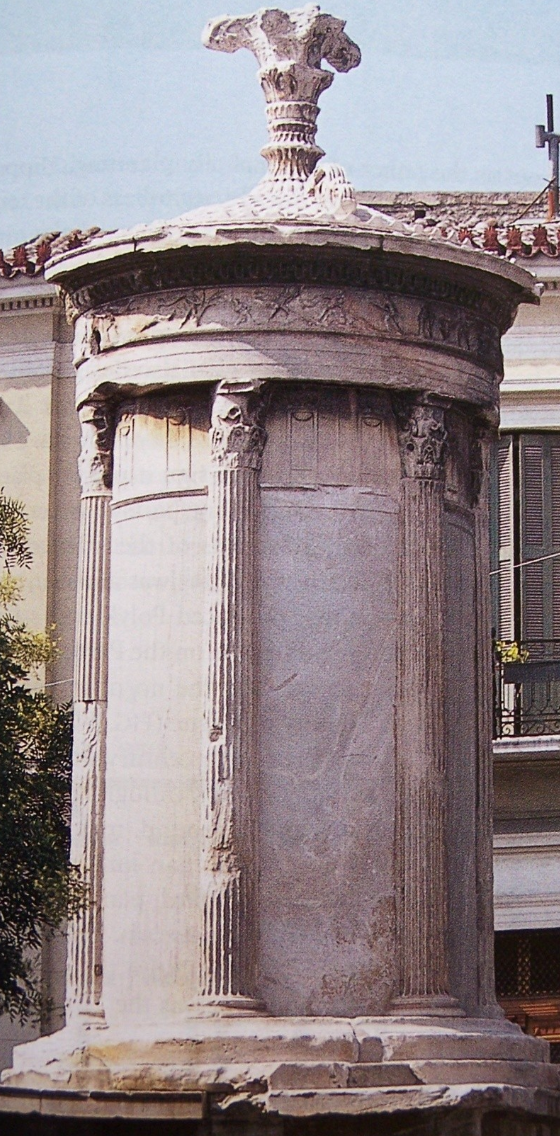
Choragic Monument of Lysikrates
late classical
It was built by Lysikrates, a wealthy citizen, to celebrate a victory in a choral competition (a choragic victory) at the theater of Dionysus.
The monument is cylindrical and decorated with Corinthian columns and friezes showing mythological scenes.
It is one of the earliest uses of the Corinthian order on a freestanding structure.
The design influenced later Roman monuments and architecture.

Altar of Zeus at Pergamon
Hellenistic Period
It was dedicated to Zeus, the king of the gods.
The altar is famous for its gigantic frieze, which wraps around the structure and shows the Gigantomachy — the battle between the gods and the giants.
The figures are dramatic and dynamic, with intense movement, twisting bodies, and expressive faces — typical of Hellenistic art.
The altar combines architecture and sculpture to create a powerful, emotional experience.
Dying Gaul
Hellenistic period
It shows a defeated Gallic warrior (a Celtic soldier) who is wounded and dying.
The sculpture is very realistic, showing muscles, pain, and exhaustion.
His expression and posture evoke empathy — viewers can feel his struggle and suffering.
It was created to celebrate a Greek victory over the Gauls, while also honoring the bravery of the enemy.
Aphrodite of Melos
Hellenistic Period
made by: Alexandros of Antioch-on-the-Meander
It represents Aphrodite, the goddess of love and beauty.
The statue is partly nude, with her upper body exposed and her arms missing (lost over time).
The pose is graceful and slightly twisting, showing movement and elegance.
The body is idealized but naturalistic, with soft curves and realistic proportions.
It reflects the Hellenistic focus on beauty, sensuality, and expressive form.
Laocoön
Hellenistic period
It shows Laocoön, a Trojan priest, and his two sons being attacked by sea serpents sent by the gods.
The figures are twisting, struggling, and full of tension, showing extreme emotion and movement.
Muscles, faces, and bodies are highly detailed, emphasizing pain, fear, and drama.
It is a famous example of Hellenistic art’s focus on drama, realism, and emotional intensity.
Terms, Concepts, and Key Non-Artist-Figures:
Krater Order
krater is a large bowl used for mixing wine and water at parties (symposia).
Shape: Wide mouth and deep body; sometimes has handles for lifting.
Kore
Archaic period
It shows a standing, clothed female figure, usually wearing a long dress (peplos or chiton).
The pose is rigid and frontal, with arms sometimes holding objects.
Many korai were used as votive offerings in temples or as grave markers.
They often have the “Archaic smile”, a slight smile meant to give life to the face.
Some were originally painted in bright colors.
(lady of auxerre)
Volute
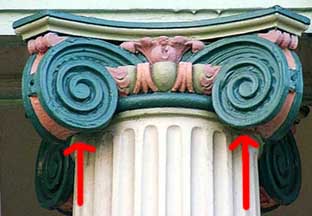
Cella
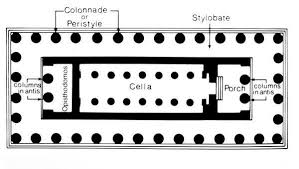
Doric Order
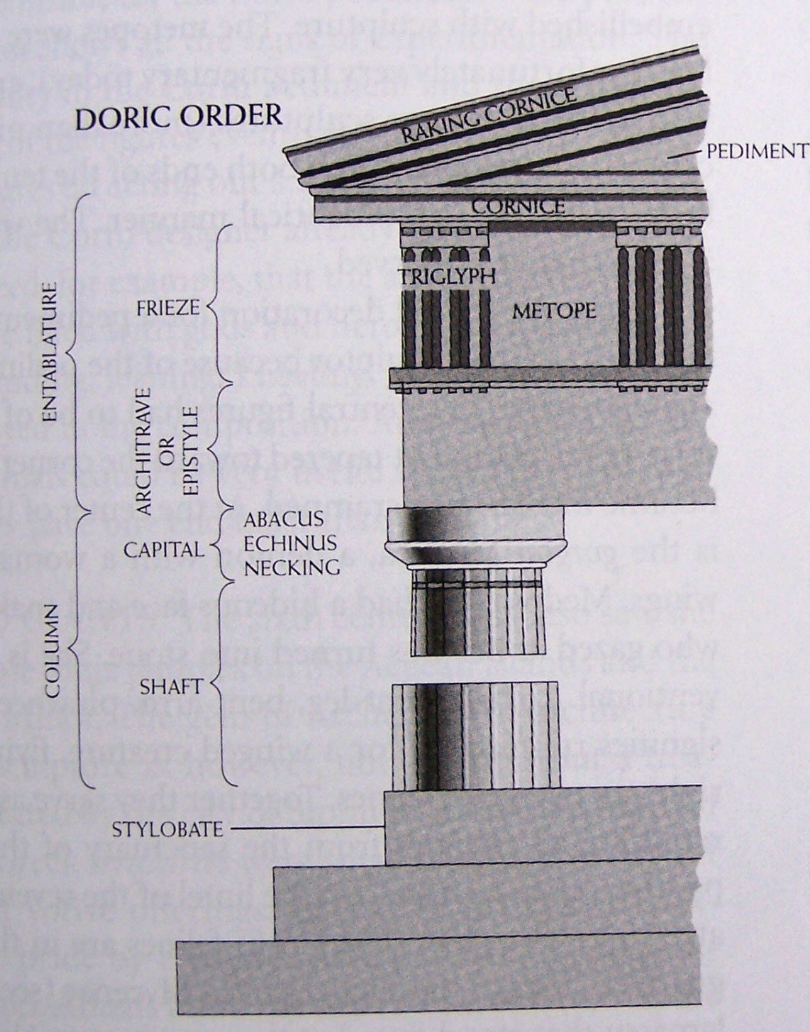
Amphora
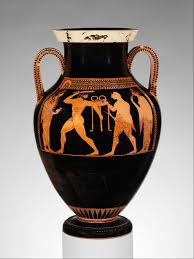
Kouros
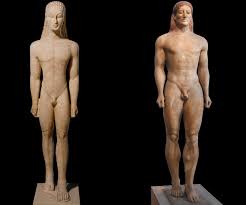
Frieze
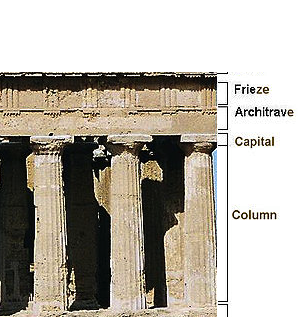
Peristyle
a row of columns surrounding a space within a building such as a court or internal garden or edging a veranda or porch.

Ionic Order
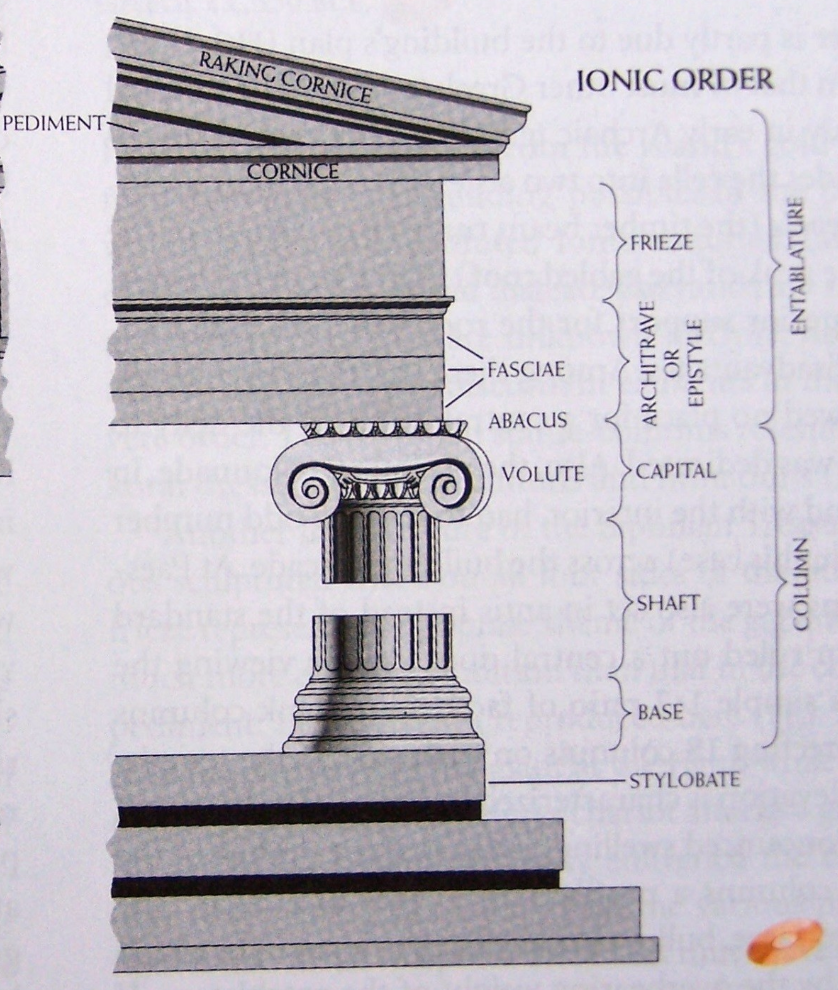
Black-Figure
Artists painted figures in black slip (a liquid clay) on the red surface of the pot.
Archaic Smile
It was used to show that the figure was alive and full of energy, not dead or emotionless
Triglyph
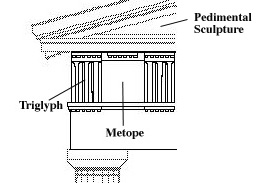
Peripteral
a peripteral building is "surrounded by columns,"
Caryatid
sculpted female figure that serves as a column or support in Greek architecture.
Red-Figure
Artists painted the background black and left the figures the natural red color of the clay.
Stylobate
A stylobate is the top step or platform that a Greek temple stands on.
The columns of the temple are placed directly on it.
Metope
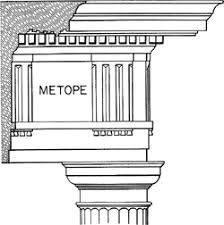
Contrapposto
Pericles
Pericles was a famous leader of Athens during its Golden Age (5th century BCE).
Entasis
Capital
Pediment
triangular part on top of columns
Corinthian Capital
The Etruscans
Model of an Etruscan Temple (Treat this as an actual building. You should be able to describe a typical Etruscan temple rather than just a model of one)
Materials: Made of wood and mud-brick, with a terracotta roof, so few original temples survive.
Columns: Usually three or more columns only at the front, not all around like Greek temples.
Plan: The temple was deep, divided into three cellae (rooms) for different gods.
Podium: Built on a high platform, so visitors had to climb stairs only at the front.
Roof decorations: The roof often had terracotta statues of gods, animals, or mythological scenes.
Orientation: Faces forward, emphasizing the front entrance.
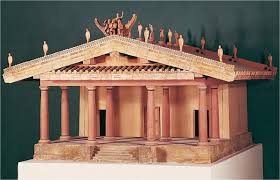
Apulu (Apollo of Veii)
t depicts Apollo, the Greek/Etruscan god of music, prophecy, and the sun.
The figure is life-sized, painted, and made of terracotta rather than stone.
Apollo is shown in motion, striding forward with one arm extended, holding a bow in the other.
The style is Archaic, with patterned hair, drapery folds, and an Archaic smile.
It was part of a roof sculpture group on an Etruscan temple.
Sarcophagus with reclining couple
It shows a man and woman reclining together on a banqueting couch, as if at a feast.
Made of terra-cotta, the figures were originally painted.
The couple is smiling and animated, showing affection and personality.
It reflects the Etruscan belief in the afterlife as a continuation of life’s pleasures.
Tomb of the Reliefs
The walls and ceilings of the tomb are covered with carved and painted stucco reliefs showing everyday objects, weapons, tools, and household items.
The decorations were meant to equip the dead for the afterlife, reflecting Etruscan beliefs that life continued after death.
The tomb has multiple chambers, like a house, to mimic a home for the dead.
Tomb of the Leopards
It is famous for its wall paintings, which cover the interior with colorful scenes.
The murals show banquets, dancing, and music, celebrating life and the dead’s social status.
Leopards are painted near the entrance, giving the tomb its name.
Figures are shown in animated, lively poses, often reclining at a banquet, reflecting Etruscan enjoyment of life.
The tomb gives insight into Etruscan funeral rituals and beliefs in the afterlife.
Terracotta
Many Etruscan statues and sarcophagi were made of terracotta because it was lightweight and easy to sculpt.
Tuscan Order
based on the Doric order but simpler and plainer.
Tuff
a type of volcanic rock made from compacted volcanic ash.
It is lightweight, soft, and easy to carve, which made it popular for building and sculpture in ancient times.
Many Etruscan tombs, temples, and city walls were made from tuff.
Over time, it hardens when exposed to air, making it durable for construction
Rome (Periods: Roman Republic, Roman Empire)
Temple of Portunus
It was dedicated to Portunus, the god of harbors and keys.
The temple combines Greek and Etruscan features:
Greek: Ionic columns and classical proportions.
Etruscan: Raised podium and front-only staircase.
The building is rectangular with a deep cella (inner chamber) and a columned porch.
Made of tufa and travertine, often covered with stucco to look like marble.
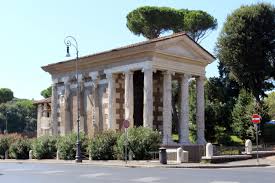
Temple of Vesta
It was dedicated to Vesta, the goddess of the hearth, home, and family.
The temple is usually round, reflecting the shape of an hearth or fire pit, which is central to Vesta’s worship.
Inside, a sacred fire was kept burning by the Vestal Virgins, priestesses of Vesta.
The temple often had columns surrounding the circular cella (a peristyle).
Made of stone and marble, sometimes decorated with stucco or bronze.
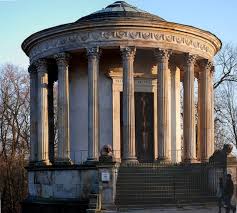
Sanctuary of Fortuna Primigenia
It was dedicated to Fortuna Primigenia, the goddess of fate and luck.
The sanctuary is built on a terraced hillside, creating a grand, multi-level approach with stairs, ramps, and ramps for processions.
It combines architecture, landscape, and views, giving a dramatic and imposing effect.
The temple features vaulted corridors, niches, and exedrae (curved seating areas), showing Roman engineering skill.
Pilgrims would climb the terraces to seek guidance or blessings from the goddess.
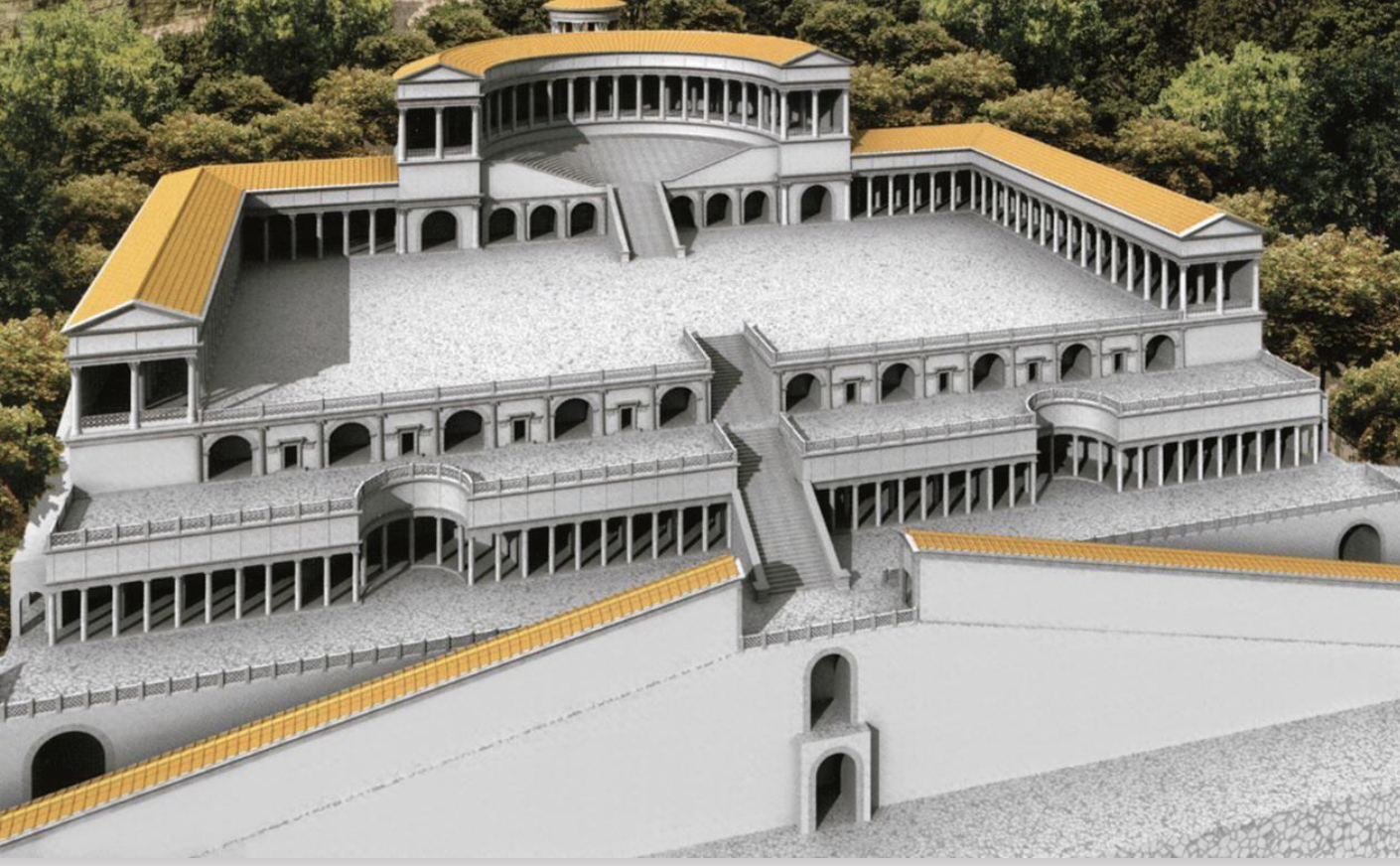
Denarius with portrait of Julius Caesar
It is one of the first Roman coins to show a living person’s portrait.
Coins like this were used for propaganda, spreading Caesar’s image and reinforcing his power across the Roman Republic.
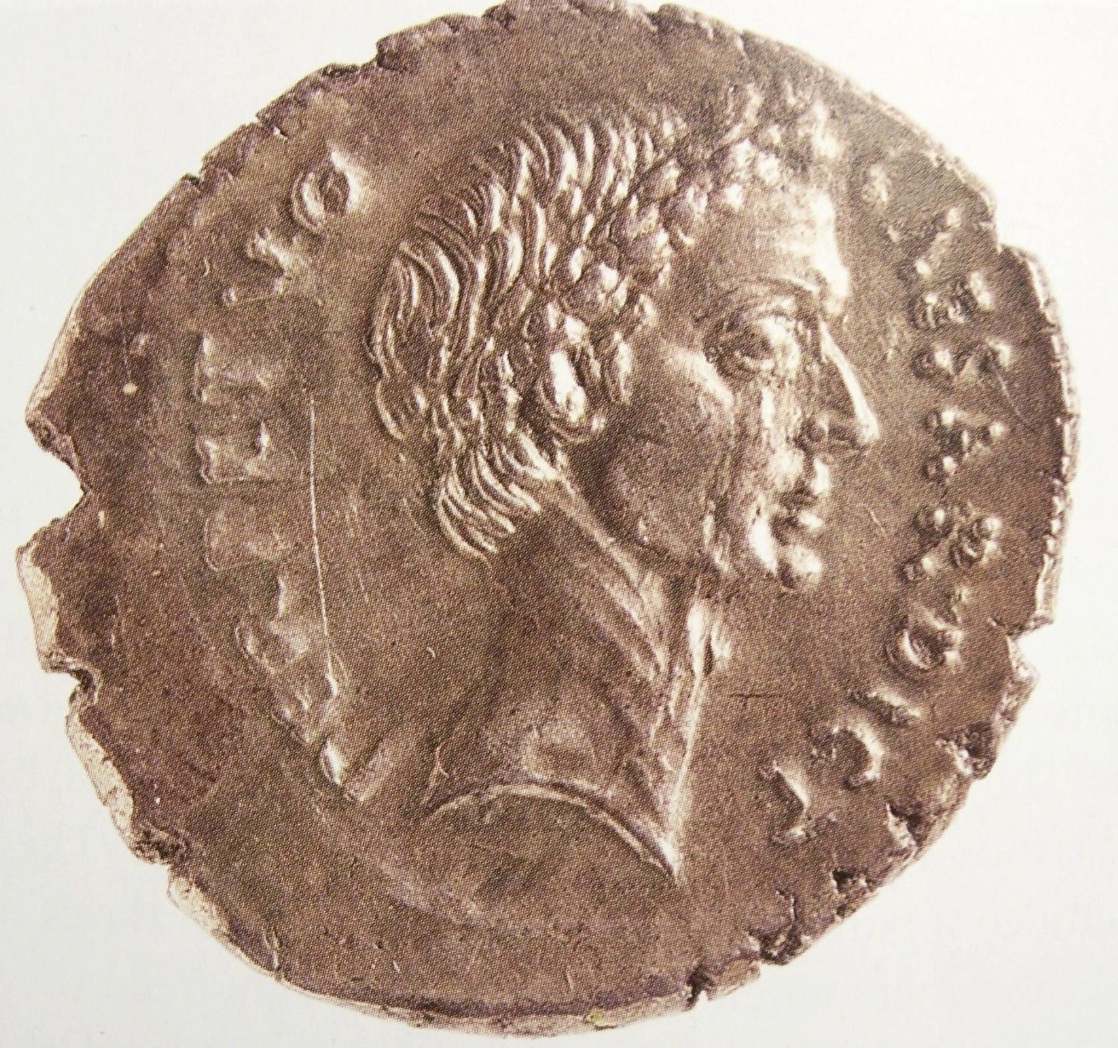
Forum of Pompeii
It was the political, religious, and commercial center of the city.
Surrounded by important buildings, such as:
Basilica (law and business)
Temple of Jupiter (religion)
Shops and markets (commerce)
The forum was a rectangular open space, paved and designed for gatherings, ceremonies, and daily activity.
It reflects Roman urban planning, combining practical, social, and religious functions in one central space.
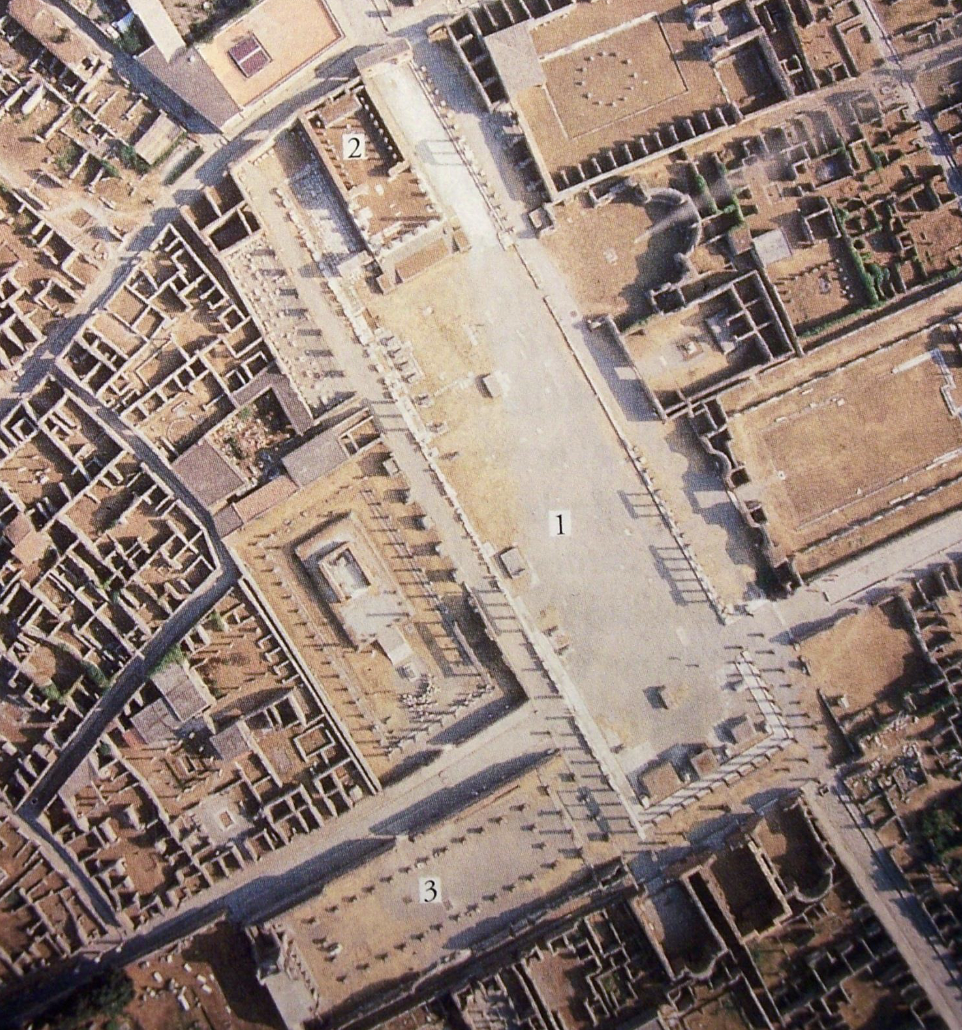
Amphitheater of Pompeii
It was used for gladiator fights, athletic events, and other public spectacles. It is one of the oldest surviving Roman amphitheaters and could hold about 20,000 people. Its design is elliptical, allowing everyone in the audience to see the action clearly.

Roman House Plan
Atrium: The central open area where guests were received; often had a small pool (impluvium) to collect rainwater.
Tablinum: The main room behind the atrium, used by the head of the household for business and meetings.
Triclinium: The dining room, usually with couches for reclining while eating.
Cubicula: Small bedrooms surrounding the atrium or other parts of the house.
Peristyle: A garden courtyard at the back, often surrounded by columns.
Kitchen (culina): A small, functional space for cooking.
Other rooms: Storage rooms, baths, and sometimes private rooms for slaves.
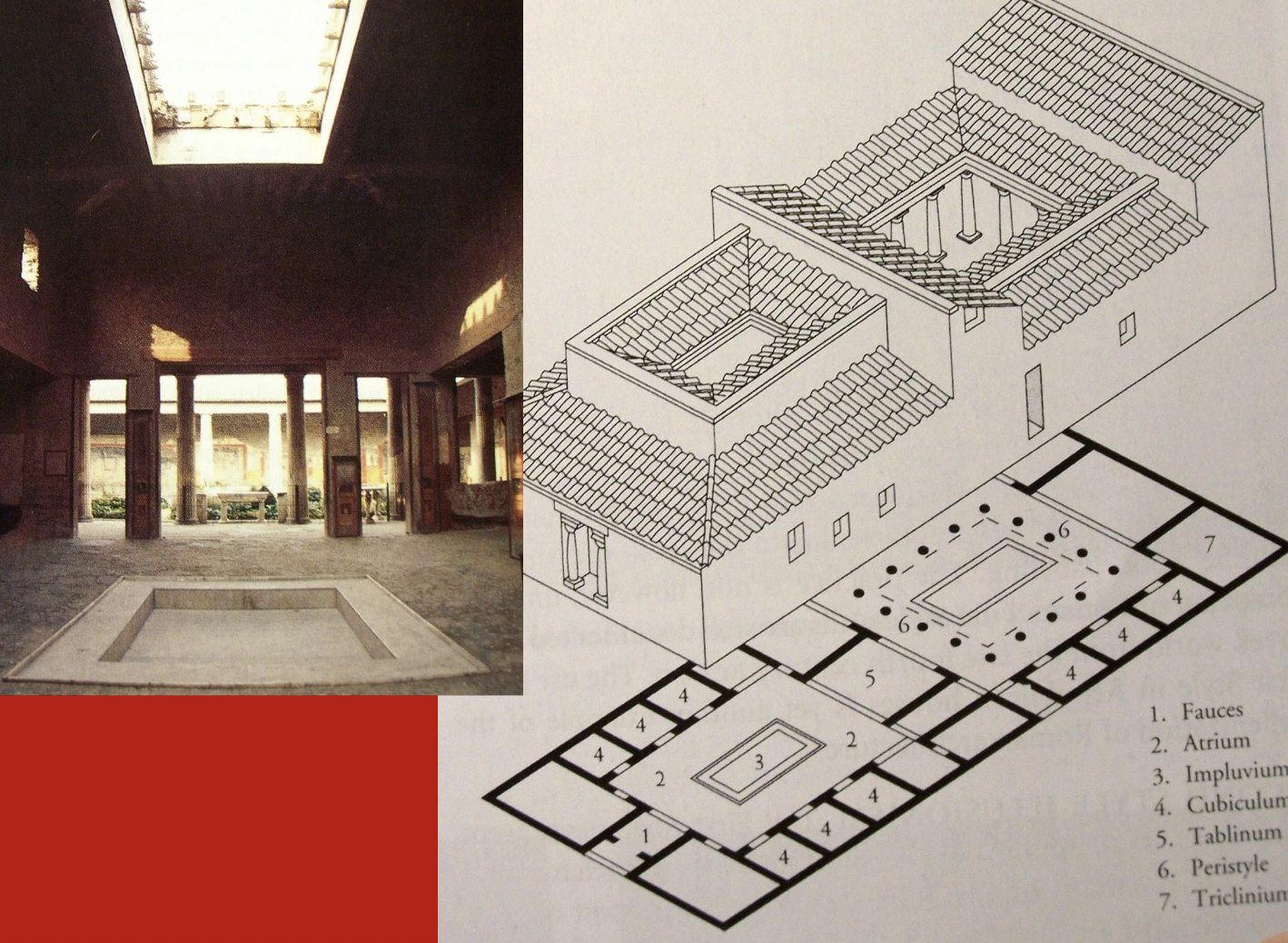
Know the Four Styles of Pompeian Painting
First Style (Incrustation Style) – 200–80 BCE
Makes walls look like they’re made of marble or expensive stone using painted plaster.
Looks more like textured panels than actual scenes.
Second Style (Architectural Style) – 80–15 BCE
Paintings create the illusion of 3D space on flat walls.
You see painted columns, windows, and landscapes that make the room feel bigger.
Third Style (Ornamental Style) – 15 BCE–50 CE
Walls are mostly flat colored backgrounds with delicate, small decorations.
Tiny landscapes or mythological scenes are often in the center.
Fourth Style (Intricate/Composite Style) – 50–79 CE
Combines elements of the Second and Third Styles.
Elaborate, busy walls with 3D illusions, framed pictures, and decorative motifs.
Portrait of Augustus as a General (ROMAN EMPIRE START)
Pose and Appearance: Augustus is shown in a heroic, commanding stance with one arm raised, as if addressing his troops.
Clothing: He wears a military breastplate (cuirass) and a cloak, emphasizing his role as a general and leader.
Style: The sculpture combines realism (lifelike face) with idealism (youthful, perfect body), showing him as both human and divine-like.
Purpose: It was propaganda, meant to show Augustus as a strong, capable leader who brought peace (the Pax Romana) after years of civil war.
Significance: Marks the beginning of the Roman Empire, celebrating the emperor’s authority, military power, and divine favor.
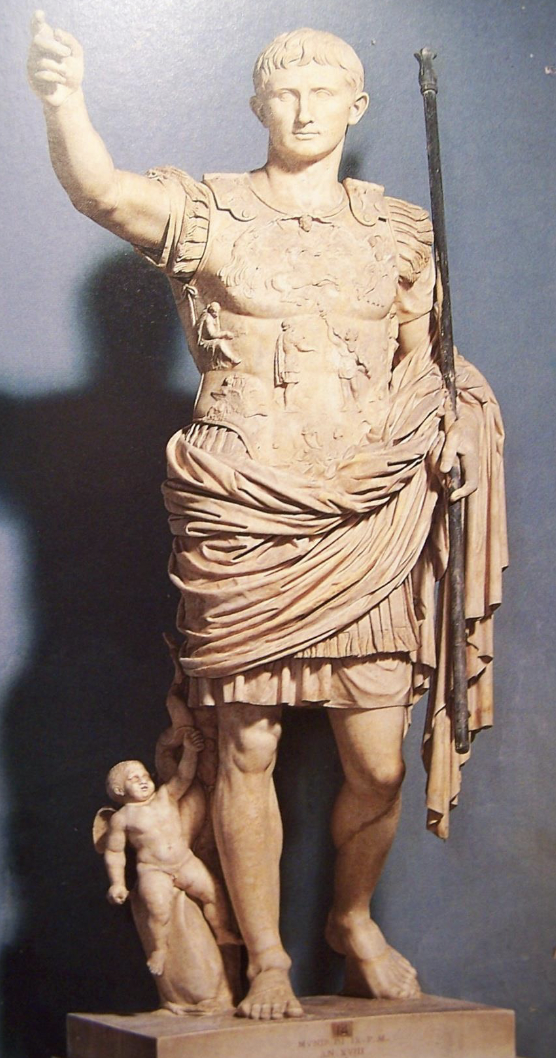
Ara Pacis, (Altar of Augustan Peace) Including images 7-30 and 7-31
t’s a celebration of Augustus’ achievements and the peace he brought, decorated with rich imagery that combines politics, religion, and art
Symbolism: The imagery communicates peace, prosperity, and the emperor’s connection to the gods.

Maison Carrée
It’s one of the best-preserved Roman temples, showing how Romans adapted Greek architecture for their own religious and political purposes.
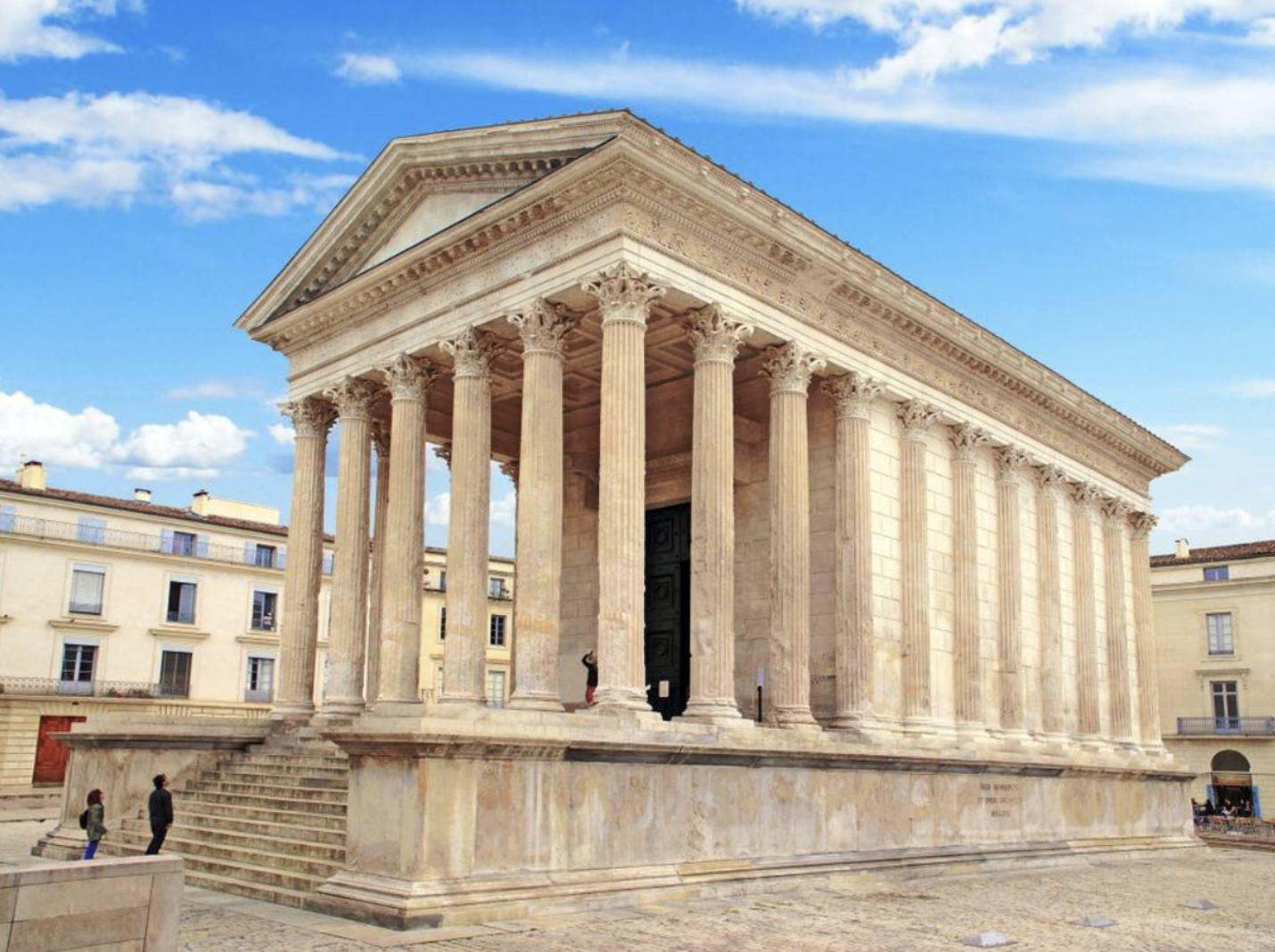
Nero’s Domus Aurea
after the great fire
Purpose: It was Nero’s private residence, designed to showcase his wealth, power, and artistic taste.
Design & Features:
Extremely large and luxurious, covering parts of the Palatine Hill.
Featured grand halls, gardens, artificial lakes, and fountains.
Famous for its innovative architecture, including octagonal rooms and rotating ceilings.
Walls and ceilings decorated with frescoes, mosaics, and stucco reliefs, often with gold accents.
Style & Significance:
Combined Roman engineering with artistic luxury.
Influenced later Roman architecture, especially the use of concrete vaults and decorative frescoes.
Legacy: After Nero’s death, much of the Domus Aurea was buried and replaced with public buildings, but its remains show the extravagance of imperial Rome.
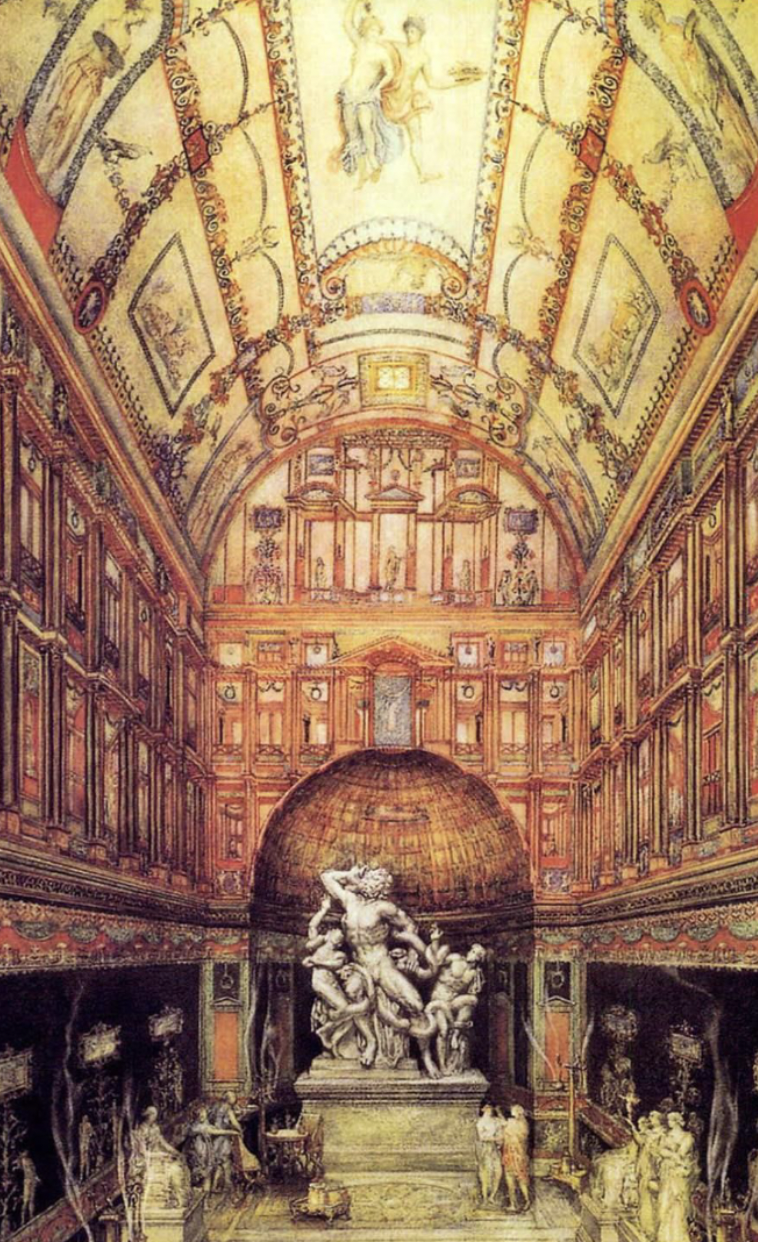
Flavian Amphitheater
Portrait of Vespasian
Arch of Titus
built around 81 CE by Emperor Domitian to honor his brother Titus and his victory in the Jewish War
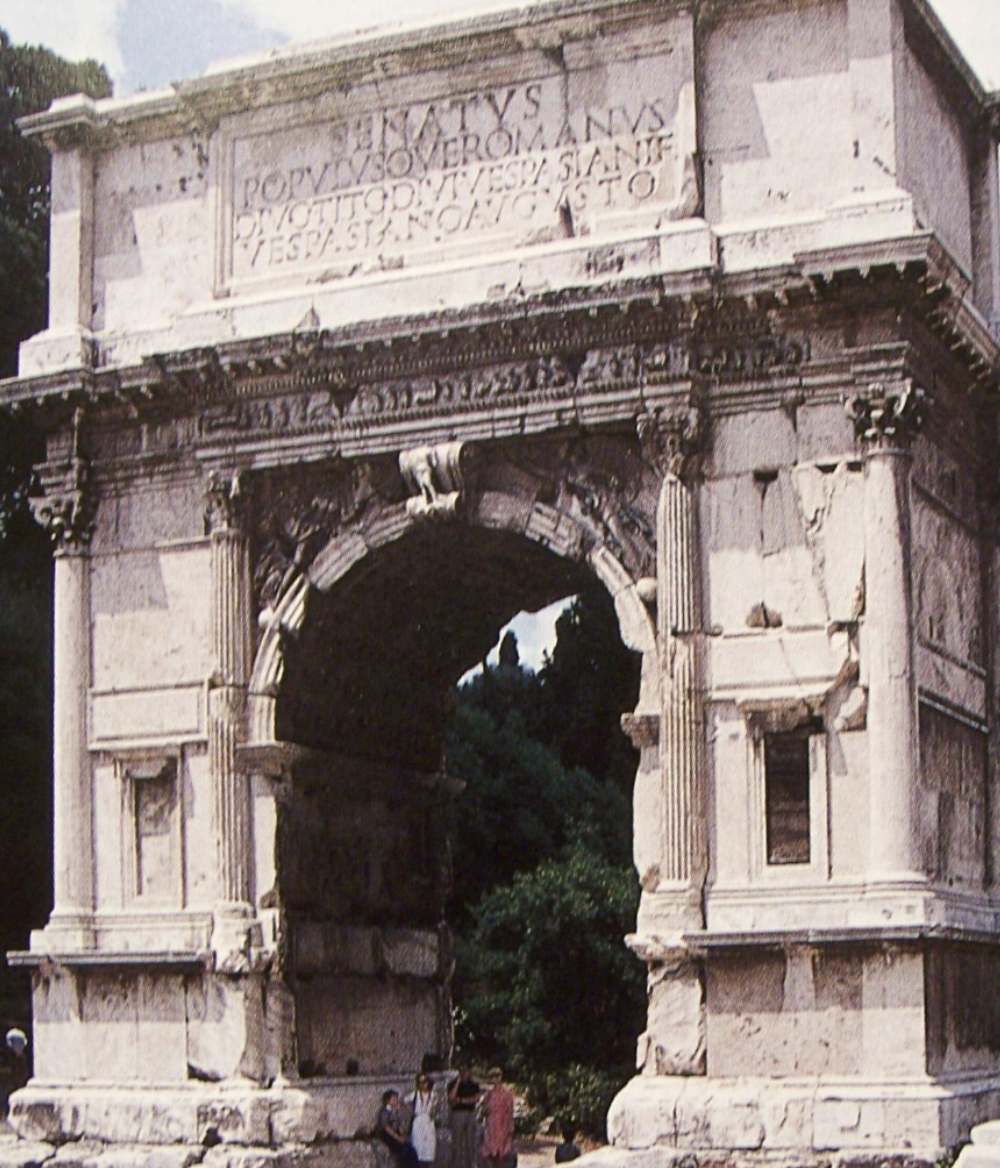
Forum of Trajan and Column of Trajan
Forum of Trajan
Purpose: A large public complex in Rome built around 112 CE under Emperor Trajan to celebrate his military victories, especially the Dacian Wars.
Design:
Included a basilica (Basilica Ulpia) for civic and legal functions.
Two libraries (Greek and Latin).
Open courtyard with statues and decorative architecture.
The forum was the largest and most grandiose in Rome, showcasing imperial power.
Significance: Demonstrated Rome’s wealth, engineering skill, and Trajan’s authority.
Column of Trajan
Purpose: A monumental victory column in the center of the forum.
Design:
Made of marble, about 98 feet tall.
Spiral reliefs wrapping around the column depict the Dacian Wars in incredible detail.
Originally topped with a statue of Trajan (later replaced by St. Peter).
Interior contains a spiral staircase.
Significance:
Served as both a monument to military success and a propaganda tool, showing Trajan as a heroic leader.
The reliefs are very naturalistic, showing soldiers, battles, and daily military life.
In short: the Forum of Trajan was a grand public space for politics and celebration, and the Column of Trajan immortalized his military victories in art.
Pantheon
Equestrian Statue of Marcus Aurelius
Purpose: Celebrates Marcus Aurelius as a powerful, wise, and just ruler.
Design & Features:
Marcus Aurelius sits calmly and confidently on a large horse, with one hand raised in a gesture of command or addressing his people.
The statue is larger than life, showing authority and presence.
Made of bronze, it survived because it was mistakenly thought to be a statue of Constantine and wasn’t melted down.
Style & Significance:
Combines realism (his facial features) with idealism (youthful, commanding appearance).
Symbolizes imperial power, control, and wisdom.
Influenced later equestrian statues in Europe, especially during the Renaissance.
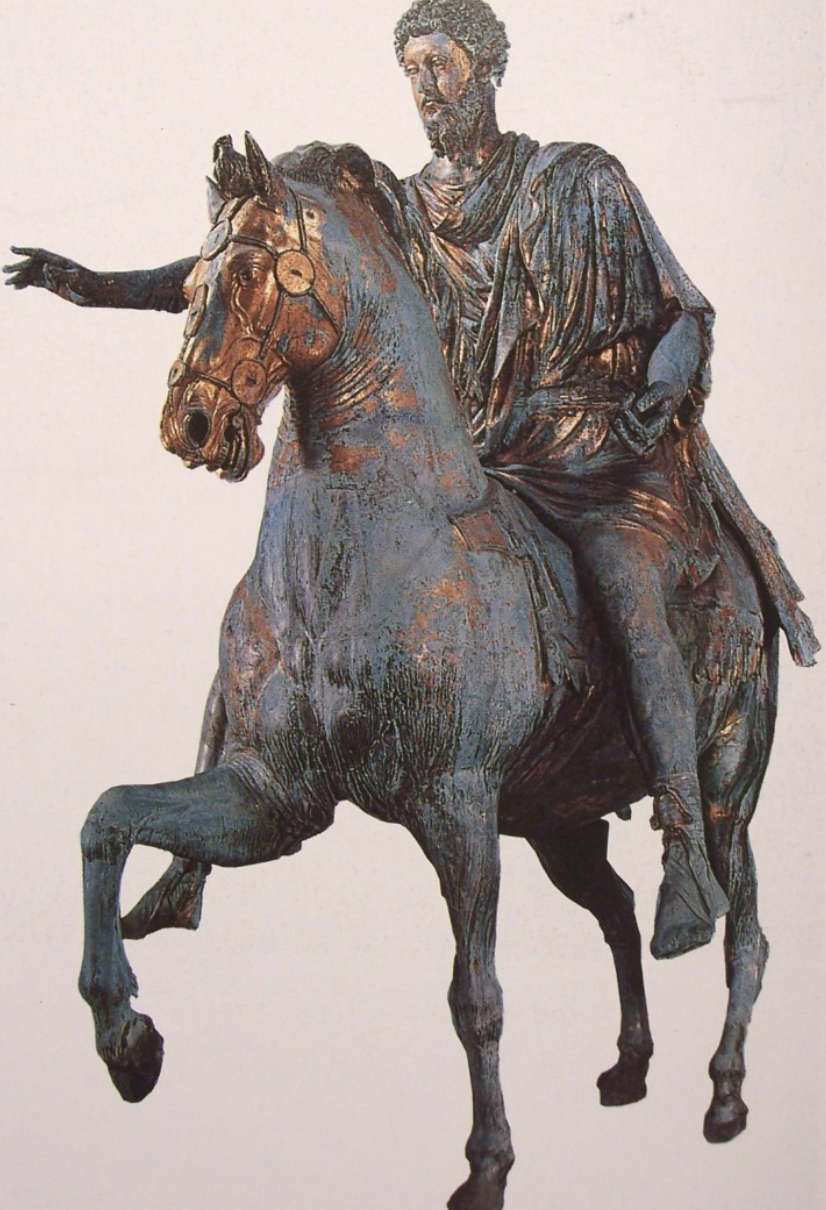
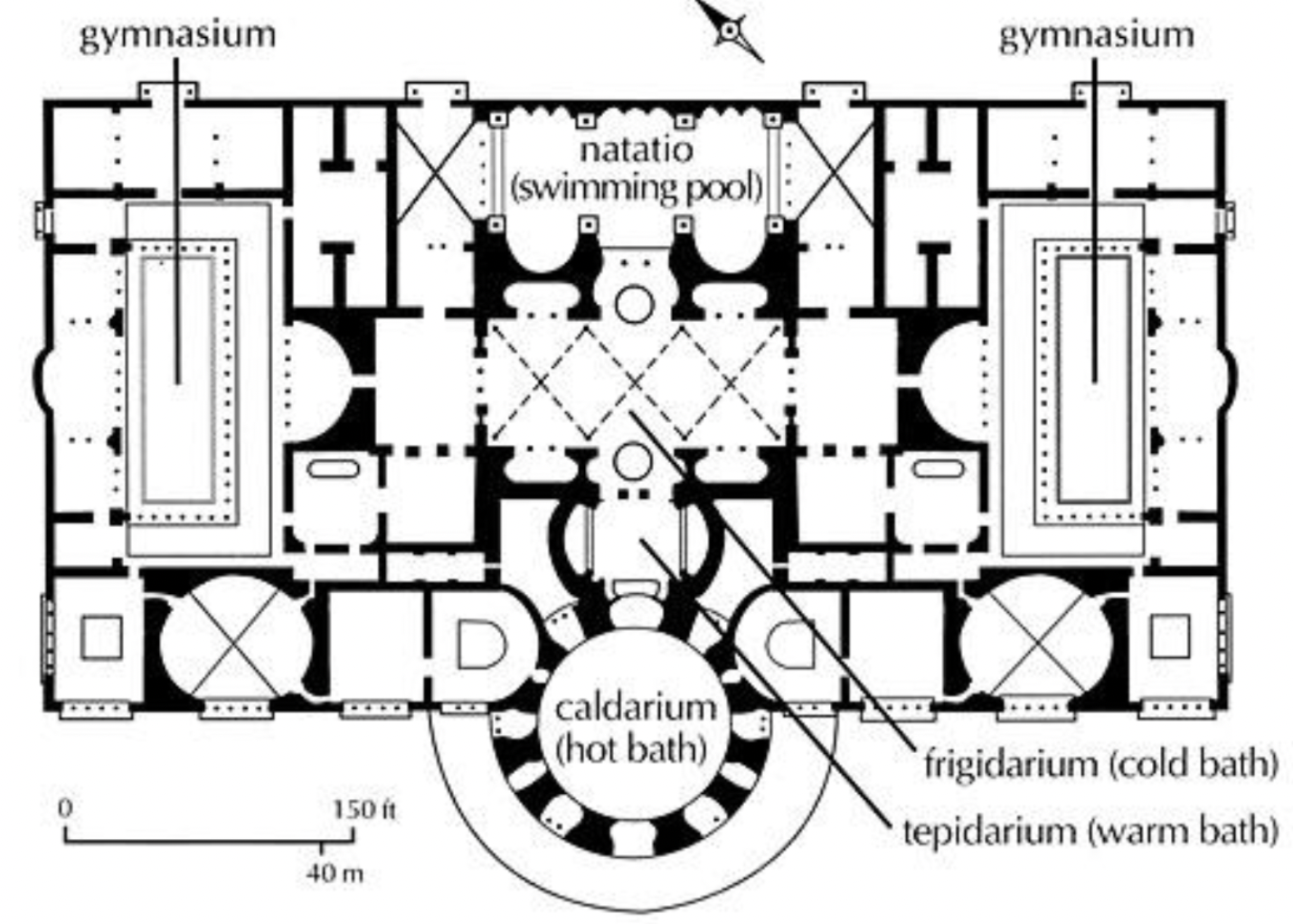
Baths of Caracalla
Purpose: Served as public baths, social spaces, and recreational centers for Romans. People went there to bathe, exercise, relax, and socialize.
Design & Features:
Huge complex covering several acres, including hot baths (caldarium), warm baths (tepidarium), cold baths (frigidarium).
Included gymnasiums, gardens, libraries, and meeting halls.
Decorated with marble, mosaics, and sculptures.
Architecture & Engineering:
Used concrete vaults and arches to create large open spaces.
Sophisticated heating system (hypocaust) warmed the floors and walls.
Significance:
Shows the wealth and engineering skill of the Roman Empire.
Functioned as both a cultural center and a demonstration of imperial generosity to the people.

Roman Concrete
Made from limestone, volcanic ash, water, and stones or rubble (caementa).
Example: The Pantheon’s dome and the Baths of Caracalla were built using Roman concrete.
Caementa
Caementa are the small pieces of stone or rubble mixed into Roman concrete.
Pseudoperipteral
Roman Vaulting Types (Barrel Vault, Groin Vault, Dome, Diagram 7-6)
Oculus
Verism
Velarium
Cardo
main north-south street in the city’s grid layout.
Decumanus
was the main east-west street in the city’s grid layout.
Atrium
atrium was the central open area and one of the most important parts of the home.
Impluvium
was a shallow pool in the floor of the atrium
Cubiculum
bedroom
Triclinium
dinning room
Three types of Roman Commemorative Sculptures or Structures
Triumphal Arch, Column Statue,
Equestrian Statue
Coffer
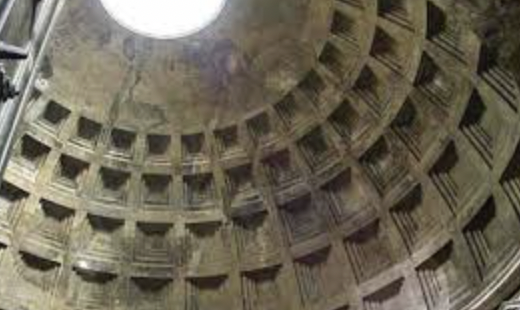
Frigidarium
cold-water room in roman baths
Tepidarium
warm-water or lukewarm room in a roman bath
Caldarium
hot-water room